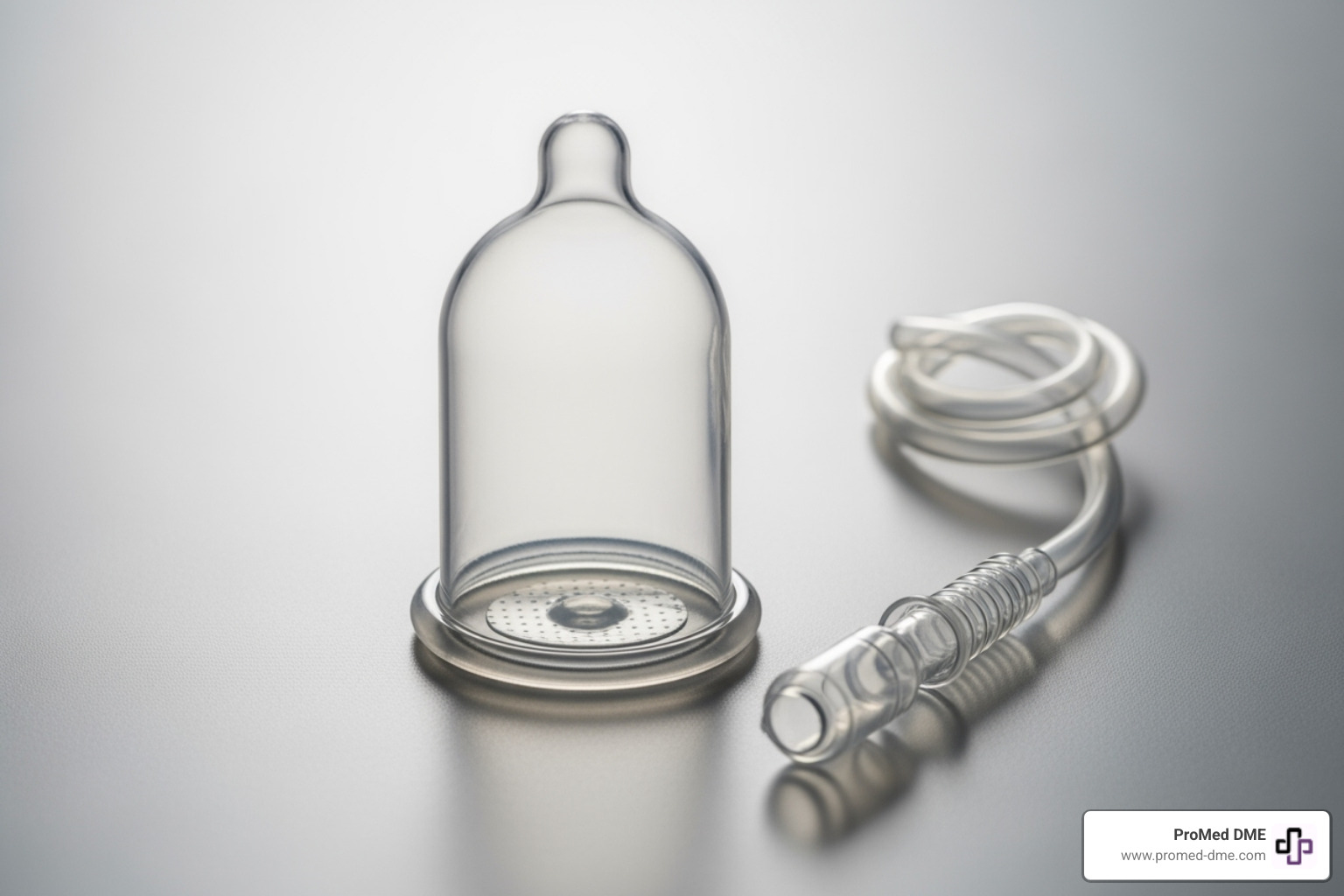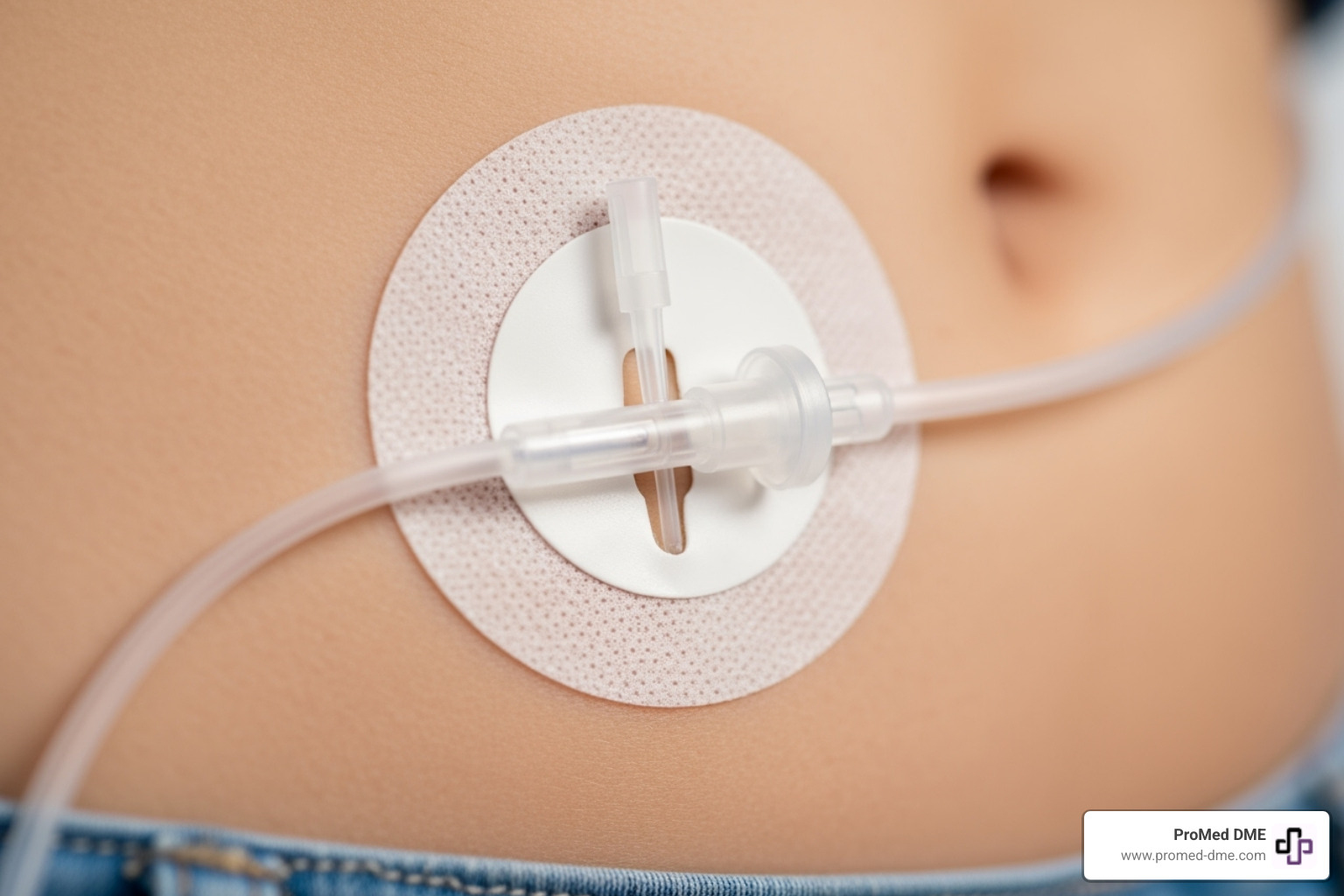External Catheters for Men: Your Guide to Function and Form
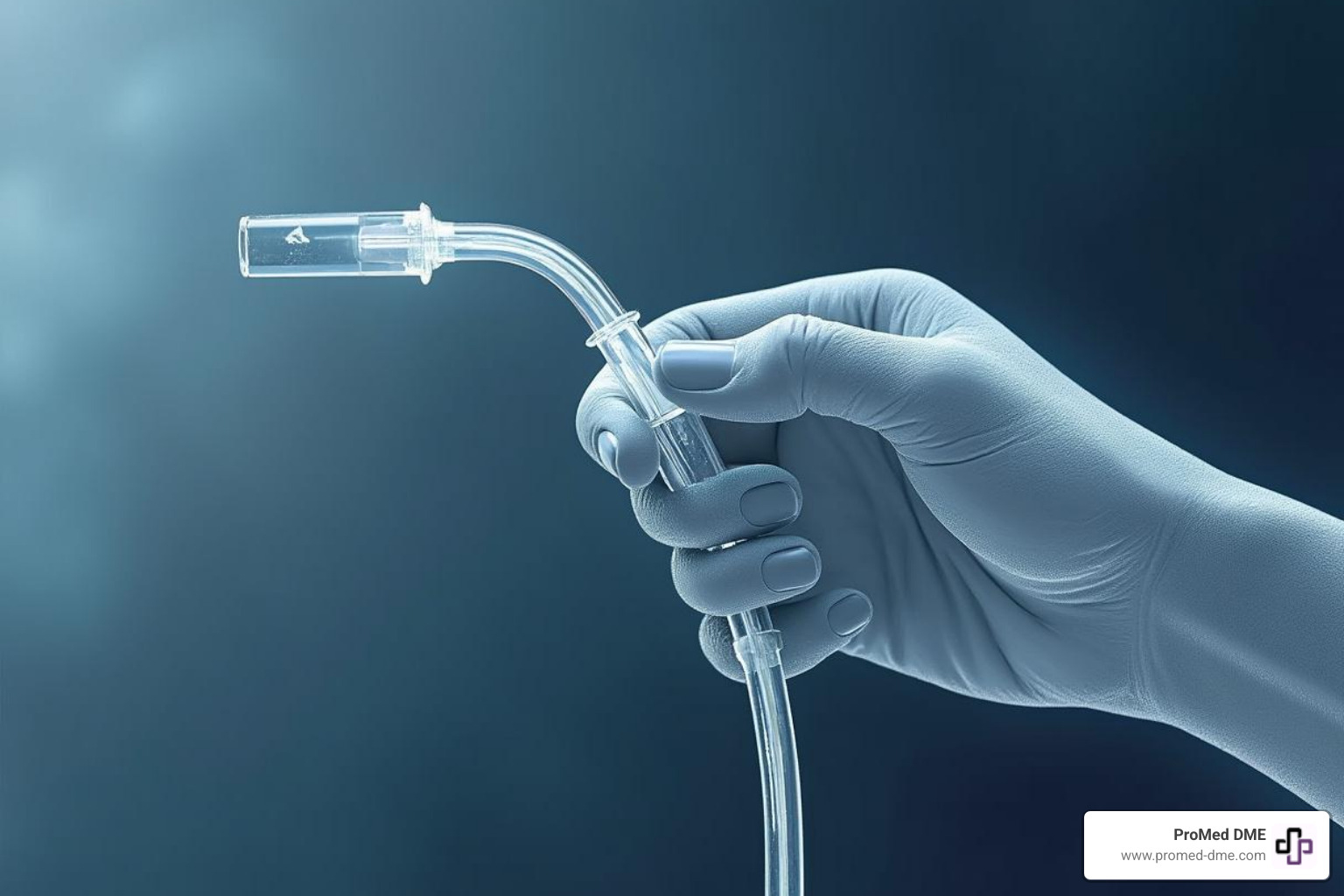
Understanding How External Catheters for Men Work
How does an external catheter for men work? It's a common question for men exploring non-invasive options for urinary incontinence. The answer is simpler than you might think.
An external catheter system works in three basic steps:
- Seal: A soft, flexible sheath, similar to a condom, fits over the penis to create a secure, leak-proof seal.
- Collect: As urine naturally leaves the body, it flows from the sheath into connected tubing.
- Store: The tubing directs the urine into a discreet collection bag, which is emptied as needed.
This external design is a game-changer. Because the device sits entirely outside the body, it offers a non-invasive alternative to internal catheters, which means a significantly lower risk of urinary tract infections (UTIs) and greater comfort.
For men managing urinary incontinence, overactive bladder, or limited mobility, external catheters can restore a sense of independence and confidence. They are an excellent alternative to adult diapers or the infection risks associated with indwelling catheters. Success lies in proper sizing, application, and daily care, which keeps skin protected and ensures you stay dry and comfortable.
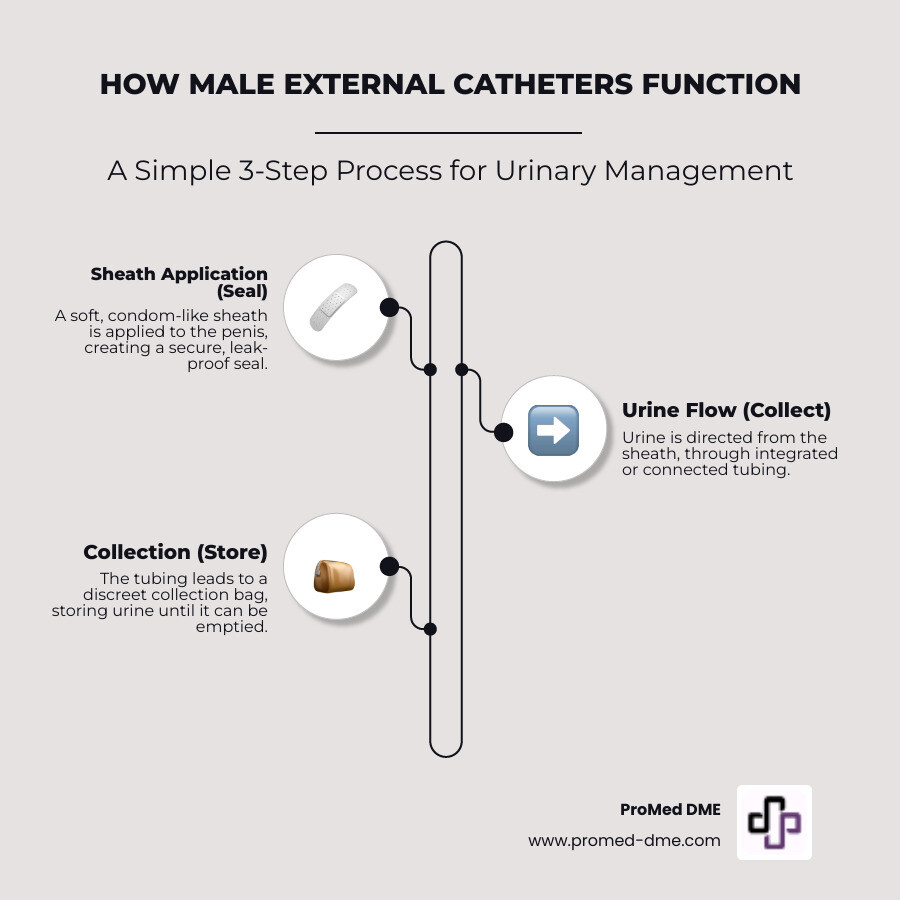
What Is a Male External Catheter?
A male external catheter, also known as a condom catheter or urinary sheath, is a non-invasive device that fits over the penis to manage urinary incontinence. Unlike internal (indwelling) catheters that are inserted into the bladder through the urethra, an external catheter simply collects urine as it leaves the body.
This external approach is its greatest advantage. By avoiding insertion into the body, it dramatically reduces the risk of catheter-associated urinary tract infections (UTIs). The CDC has even recommended external catheters as a safer alternative for male patients who do not have urinary retention. Most are made from soft, flexible silicone, which is generally preferred over latex as it is more breathable and hypoallergenic, reducing the risk of skin irritation. More on the different kinds of catheters.
Key Advantages Over Other Methods
- Reduced Infection Risk: With no internal components, the pathway for bacteria to enter the bladder is eliminated.
- Skin Protection: By wicking urine away from the skin, these catheters help prevent incontinence-associated dermatitis (painful rashes and skin breakdown).
- Comfort and Independence: They are less bulky and more discreet than adult diapers or pads. A user study found that 80% of men agreed external catheters are comfortable to wear.
- Non-Invasive: Application is simple and gentle, with no need for a medical procedure.
- Discretion: The catheter connects to a small leg bag that can be hidden under clothing, allowing you to maintain an active and social lifestyle with confidence. Learn more about condom catheter use.
When an External Catheter Might Not Be Suitable
External catheters are highly effective, but they are not the right solution for everyone. Their main limitation is that they require the bladder to empty on its own. They are not suitable for men with:
- Urinary Retention: The inability to empty the bladder naturally.
- Bladder Outlet Obstruction: A blockage, such as from an enlarged prostate, that prevents urine from flowing freely.
- Neuropathic Bladder: Nerve damage that affects the bladder's ability to empty.
Always consult with a healthcare provider to diagnose the cause of your incontinence and determine the best management approach for your specific needs.
Who Can Benefit from Using an External Catheter?
Male external catheters can be a life-changing solution for men facing a wide range of urinary challenges, restoring dignity and independence.

Here’s a look at who can benefit most:
- Men with Urinary Incontinence: Whether it's stress incontinence (leaks from coughing or exercise), urge incontinence (sudden, strong urges), or overflow incontinence (constant dribbling), an external catheter provides reliable, discreet protection.
- Men with Overactive Bladder (OAB): For those who can't always make it to the bathroom in time, an external catheter offers peace of mind and prevents accidents.
- Individuals with Limited Mobility: For men who use a wheelchair, are bedridden, or have difficulty moving quickly, an external catheter eliminates the stressful rush to the toilet.
- Patients with Dementia: When cognitive changes make it difficult to recognize the need to urinate, these devices simplify care, prevent accidents, and keep skin healthy.
- Post-Surgery Recovery: After procedures that temporarily affect mobility or cause incontinence, an external catheter can be a helpful bridge during the healing process.
- Men with Nighttime Frequency or Bedwetting: An external catheter connected to a bedside bag allows for uninterrupted sleep, reducing the risk of nighttime falls associated with rushing to the bathroom.
- Anyone Prone to Skin Irritation: By keeping urine away from the skin, external catheters are an excellent tool for preventing incontinence-associated dermatitis.
To find out if an external catheter is the right choice for you, find a urology specialist for a consultation to get professional guidance.
How Does an External Catheter for Men Work? A Step-by-Step Guide
Proper application and removal are the keys to success with an external catheter. While it may feel awkward at first, mastering the technique will ensure comfort, prevent leaks, and protect your skin.
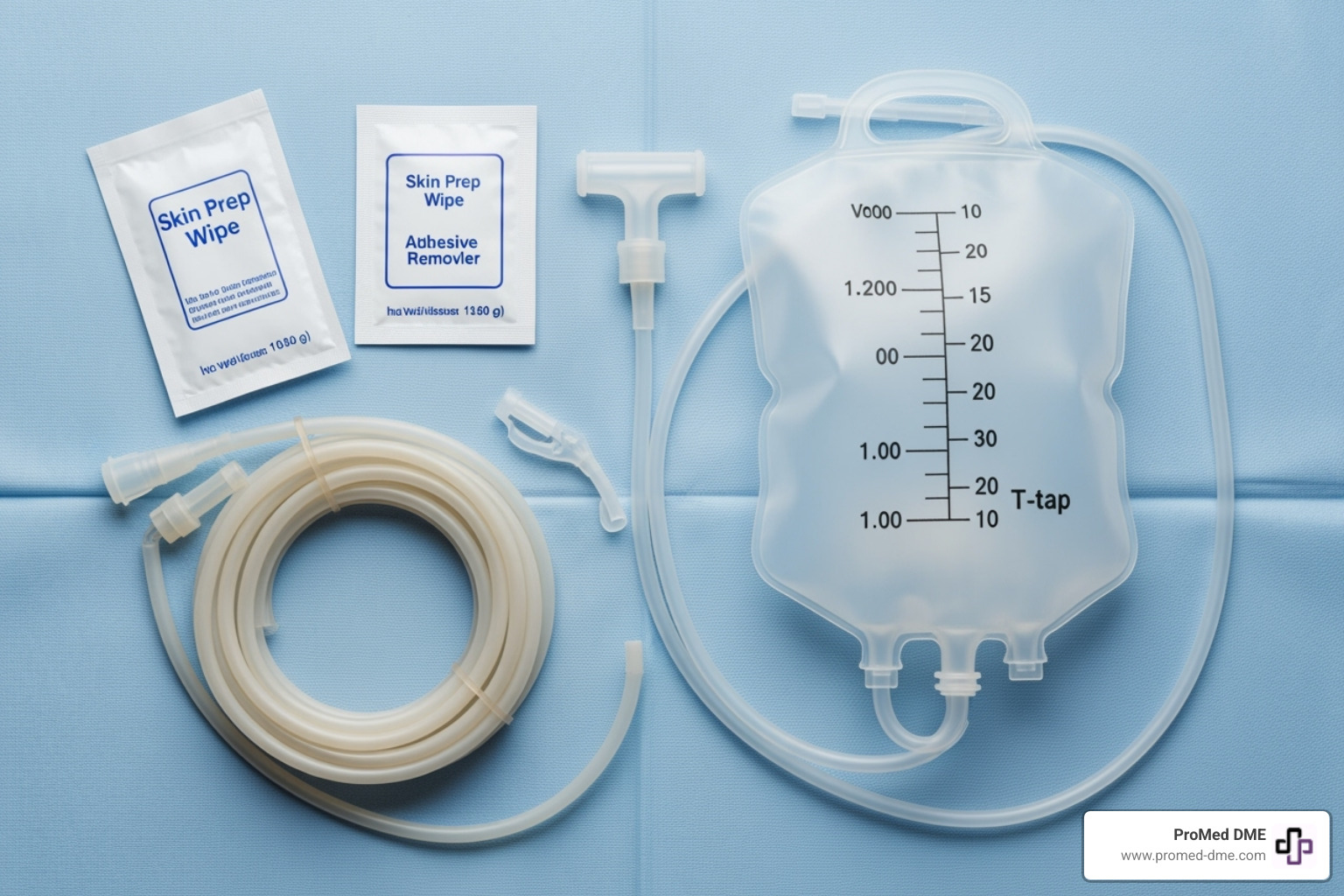
Essential Components of an External Catheter System
A complete system includes:
- Catheter Sheath: The soft, flexible sleeve that fits over the penis. Most modern sheaths are self-adhering.
- Skin Barrier Wipes: Optional but recommended wipes that create a protective film on the skin to improve adhesion and prevent irritation.
- Collection Tubing: Connects the sheath to the drainage bag.
- Drainage Bags: Come in two main types: a smaller leg bag for daytime mobility and a larger bedside bag for overnight use.
Find all necessary supplies here.
How to Choose the Correct Size
Getting the right size is critical. A catheter that is too loose will leak, while one that is too tight can restrict blood flow and cause pressure sores. To find your size, wrap a measuring tape around the shaft of your penis (not the head) to find the circumference. Divide that number by 3.14 to get your diameter in millimeters. Match this measurement to the manufacturer's sizing guide. When in doubt, it is better to be slightly too large than too small.
The Application Process
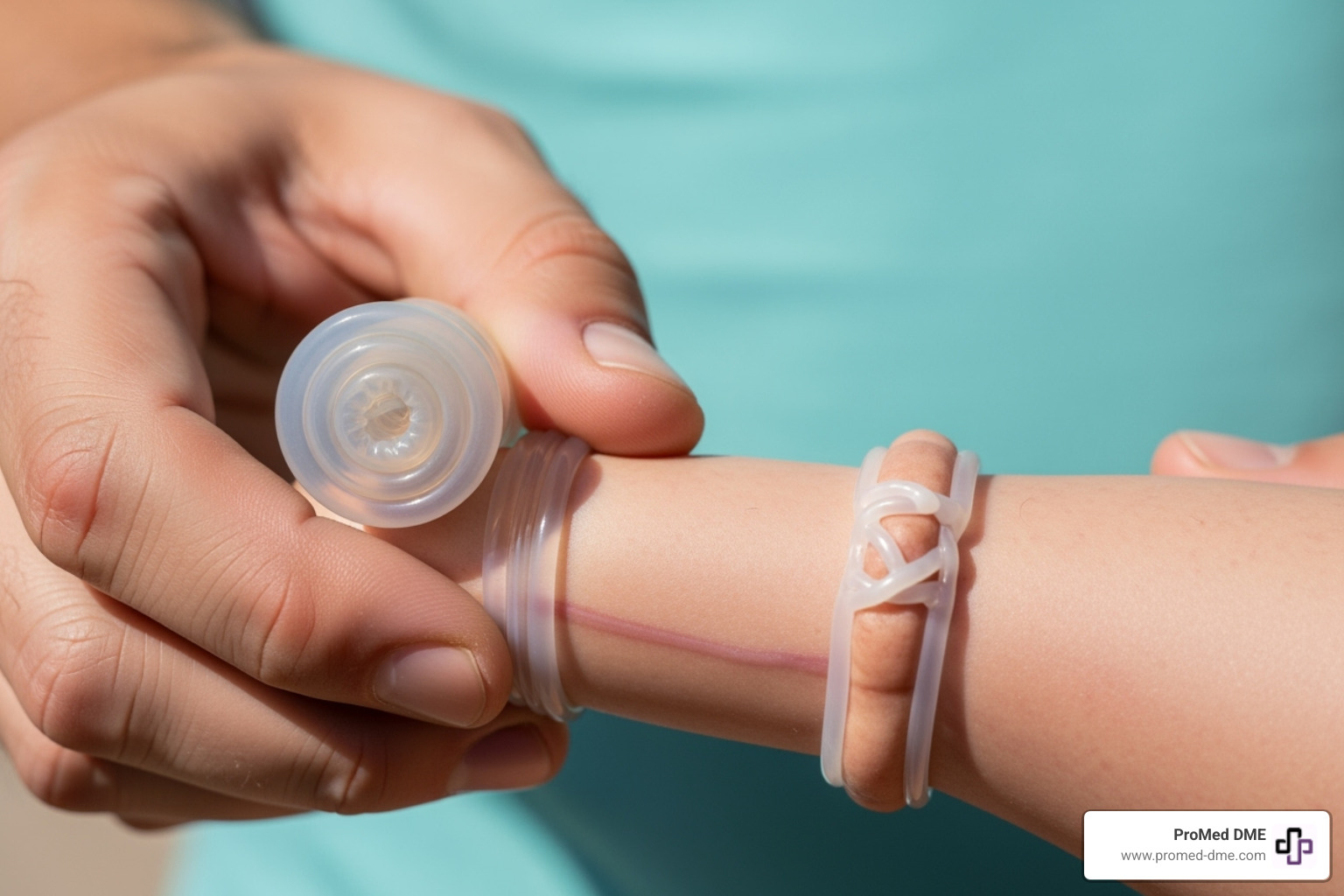
- Prepare: Wash your hands. Trim any pubic hair at the base of the penis to prevent it from getting caught in the adhesive. Wash the penis with mild, residue-free soap and water, then pat completely dry. Adhesive will not stick to damp skin.
- Protect (Optional): Apply a skin barrier wipe to the penis and allow it to dry completely.
- Position: For uncircumcised men, ensure the foreskin is in its natural, forward position. Never apply the catheter with the foreskin retracted, as this can cause dangerous swelling.
- Apply: Place the rolled catheter over the tip of the penis and gently unroll it down the shaft. Leave about 1 inch of space between the tip of the penis and the end of the catheter funnel.
- Secure: Smooth out any wrinkles. If the catheter is self-adhering, press gently for 10-20 seconds to warm the adhesive and create a secure seal.
Safe and Gentle Removal
- Change Daily: Replace your catheter at least once every 24 hours to clean and inspect your skin.
- Loosen Adhesive: Wrap a warm, wet washcloth around the catheter for 30-60 seconds to loosen the adhesive. An adhesive remover wipe can also be used.
- Remove: Gently roll the catheter off. Never pull or yank it, as this can tear the skin.
- Inspect and Clean: After removal, check the skin for any redness or irritation. Wash the area again with mild soap and water and dry thoroughly before applying a new catheter.
Best Practices for Daily Care and Maintenance
Mastering how an external catheter works involves developing a consistent daily care routine. These habits are vital for hygiene, comfort, and preventing common complications.
Ongoing Management
- Change the Catheter Daily: An external catheter must be replaced at least once every 24 hours, or immediately if it becomes soiled or feels loose. This is crucial for skin health and hygiene.
- Empty the Collection Bag Regularly: Empty your leg or bedside bag when it is about half full. This prevents the weight of a full bag from pulling on the catheter and reduces the risk of urine backflow.
- Clean Reusable Supplies Daily: To prevent odor and bacteria, clean your drainage bags and tubing every day. Rinse with water, soak for 20-30 minutes in a solution of 1 part white vinegar to 10 parts water, rinse again, and hang to air dry.
More tips on using an external catheter.
Preventing and Managing Common Complications
- Leakage: This is almost always a sizing issue. If your catheter leaks, you are likely using a size that is too large. Re-measure to ensure a proper fit. Hair or damp skin can also interfere with the adhesive seal.
- Skin Irritation: Redness or itching can be caused by an allergy to the material (e.g., latex), trapped moisture, or adhesive remover. Try switching to a silicone catheter and always ensure skin is completely dry before application. A skin barrier wipe can provide an extra layer of protection.
- Pressure Sores: These are a serious sign that the catheter is too tight, restricting blood flow. If you see any dark spots or skin breakdown, discontinue use immediately and consult your healthcare provider. Never wrap adhesive strips tightly.
- Penile Retraction: If the penis retracts, making it difficult to keep a catheter on, speak with your healthcare provider. There may be different products or techniques that can help.
Regularly inspect your skin for any signs of trouble. If you have nerve damage, this visual check is especially important. If you experience persistent problems, contact your healthcare provider or our team at ProMed DME for assistance.
Read about the benefits of proper use.
Understanding How External Catheters for Men Work
External catheters sit on the outside of the body. In short: the sheath seals around the penis, urine flows through tubing, and a bag stores it until emptied. This non-invasive setup lowers UTI risk and can be more comfortable than internal options.
- Seal - A soft sheath (like a condom) creates a secure seal around the penis
- Collect - Urine flows through tubing connected to the sheath
- Store - A collection bag holds the urine until it's emptied
Easy how does an external catheter for men work word list:
What Is a Male External Catheter?
A male external catheter (also called a condom catheter or urinary sheath) fits over the penis to collect urine as it leaves the body. Because nothing is inserted into the urethra or bladder, infection risk is typically lower than with indwelling catheters. Most are soft silicone for comfort and skin-friendliness. More on the different kinds of catheters.
Key Advantages Over Other Methods
- Reduced infection risk
- Keeps urine off skin to help prevent irritation
- Non-invasive, discreet under clothing
- Often more comfortable than pads
Not ideal if you have urinary retention, bladder outlet obstruction, or a neuropathic bladder that doesn’t empty on its own. Learn more about condom catheter use.
Who Can Benefit from Using an External Catheter?
External catheters can help:
- Men with urinary incontinence (stress, urge, overflow)
- Those with overactive bladder who can’t always reach the toilet in time
- Individuals with limited mobility or dementia (simplifies care, protects skin)
- Post-surgery recovery and men with nighttime frequency or bedwetting
How Does an External Catheter for Men Work? A Step-by-Step Guide
A good fit, clean/dry skin, and gentle removal are the essentials.
- Size: Measure circumference, convert to diameter, match manufacturer’s guide.
- Apply: Wash hands, trim hair, clean and fully dry. If uncircumcised, keep foreskin in its natural position. Unroll the sheath, leave space at the tip, smooth wrinkles.
- Remove daily: Loosen with a warm, wet cloth or adhesive remover; roll off gently; inspect skin.
Find all necessary supplies here.
Best Practices for Daily Care and Maintenance
- Change at least every 24 hours (earlier if soiled or loose).
- Empty the bag when half full to prevent pull and backflow.
- Clean bags/tubing daily: rinse, then soak 20–30 minutes in 1:10 white vinegar:water; rinse and air dry.
More tips on using an external catheter Read about the benefits of proper use
Understanding How External Catheters for Men Work
External catheters collect urine without entering the body, helping reduce UTI risk and improve comfort.
- Seal
- Collect
- Store
Easy how does an external catheter for men work word list:
What Is a Male External Catheter?
A male external catheter (condom catheter/urinary sheath) goes over the penis like a sleeve to collect urine as it exits, rather than draining the bladder from inside. This often means lower UTI risk and greater day-to-day comfort. Many users prefer silicone for breathability and skin sensitivity. More on the different kinds of catheters.
Key perks: non-invasive, discreet, skin-protective. Not suitable if you cannot empty your bladder naturally. Learn more about condom catheter use.
Who Can Benefit from Using an External Catheter?
Great for men with:
- Urinary incontinence (stress, urge, overflow)
- Overactive bladder with urgent, frequent trips
- Limited mobility or dementia (simplifies care)
- Nighttime frequency/bedwetting or short-term post-surgery needs
How Does an External Catheter for Men Work? A Step-by-Step Guide
Keep it simple and safe:
- Choose the correct size (based on diameter).
- Prepare skin: wash, dry, trim hair; keep foreskin in natural position.
- Apply by unrolling the sheath and smoothing wrinkles; leave space at the tip.
- Remove every 24 hours using a warm, wet cloth or adhesive remover; roll off gently and inspect skin.
Find all necessary supplies here.
Best Practices for Daily Care and Maintenance
- Replace daily (or sooner if soiled/loose).
- Empty the bag at half-full to avoid tugging/backflow.
- Clean bag/tubing daily (1:10 white vinegar:water soak for 20–30 minutes).
More tips on using an external catheter Read about the benefits of proper use
Understanding How External Catheters for Men Work
Non-invasive, lower-UTI-risk solution that collects urine externally.
- Seal
- Collect
- Store
Easy how does an external catheter for men work word list:
What Is a Male External Catheter?
A soft sheath fits over the penis to collect urine externally, avoiding insertion and helping reduce UTI risk. Silicone models are popular for comfort and skin health. More on the different kinds of catheters.
Best when your bladder can empty on its own; not for urinary retention, outlet obstruction, or neuropathic bladder. Learn more about condom catheter use.
Who Can Benefit from Using an External Catheter?
- Urinary incontinence (stress, urge, overflow)
- Overactive bladder
- Limited mobility or dementia
- Nighttime frequency/bedwetting and short-term post-surgery support
How Does an External Catheter for Men Work? A Step-by-Step Guide
- Measure correctly for a snug-but-safe fit.
- Prep skin (wash, dry, trim hair); if uncircumcised, keep foreskin forward.
- Unroll the sheath, leave space at the tip, smooth wrinkles.
- Remove and replace daily; loosen with warm water/adhesive remover, roll off gently.
Find all necessary supplies here.
Best Practices for Daily Care and Maintenance
- Daily change; sooner if soiled or loose.
- Empty bag at half-full.
- Clean bag/tubing daily (rinse, soak 20–30 minutes in 1:10 white vinegar:water, rinse, air dry).
More tips on using an external catheter Read about the benefits of proper use
Understanding How External Catheters for Men Work
External catheters collect urine outside the body to keep skin dry and reduce UTI risk.
- Seal
- Collect
- Store
Easy how does an external catheter for men work word list:
What Is a Male External Catheter?
A condom-style sleeve worn over the penis that channels urine to a bag, avoiding insertion and lowering UTI risk. Typically silicone for comfort and breathability. More on the different kinds of catheters.
Use only if you can empty your bladder naturally; not suitable for urinary retention or outlet obstruction. Learn more about condom catheter use.
Who Can Benefit from Using an External Catheter?
- Urinary incontinence (stress, urge, overflow)
- Overactive bladder
- Limited mobility or dementia (simplifies care, protects skin)
- Nighttime frequency/bedwetting; short-term post-surgery help
Find a urology specialist for a consultation
How Does an External Catheter for Men Work? A Step-by-Step Guide
- Size carefully; follow manufacturer’s guide.
- Prep: clean, dry skin; trim hair; foreskin in natural position.
- Apply by unrolling; leave tip space; smooth wrinkles.
- Remove daily with warm water/adhesive remover; roll off and inspect skin.
Find all necessary supplies here.
Best Practices for Daily Care and Maintenance
- Change daily (earlier if soiled/loose).
- Empty bags at half-full.
- Clean bags/tubing daily: rinse, soak 20–30 minutes in 1:10 white vinegar:water, rinse, air dry.
More tips on using an external catheter Read about the benefits of proper use
Recursos y artículos relacionados
Manténgase informado con las entradas de nuestro blog informativo.
Descubra las ventajas de ProMed
y pruebe nuestros productos
Ofrecemos envío gratuito y un legendario servicio de atención al cliente para garantizar que reciba los
mejores productos de DME para sus necesidades.

